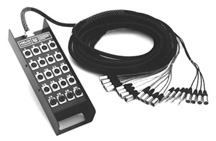The Basics of Selecting and Using Audio Snakes
Do you find yourself constantly taping down several long microphone cables just to have to wind them up again? Do you worry about people tripping over the tangled mess of cables used for your services or performances? Then you may be the perfect candidate for an audio snake.
This handy device groups all your mic and return lines in one cable, offering greater portability, efficiency and neatness than a set of separate cables.
Snakes are specially built, single cables that have multiple connections at each end. The words “fan” and “box” describe common ways these  ends are terminated. A “fan end” has separate connectors which reach out to various components. A “box end” of a snake is a rectangular box housing connection points for return lines. A fan is usually used at the mixer end of the snake, while the box end is placed on the stage or platform so performers can plug in their mic and instrument cables. Special application snakes are available that terminate with a blunt end connector that can be attached to a separate fan or box.
ends are terminated. A “fan end” has separate connectors which reach out to various components. A “box end” of a snake is a rectangular box housing connection points for return lines. A fan is usually used at the mixer end of the snake, while the box end is placed on the stage or platform so performers can plug in their mic and instrument cables. Special application snakes are available that terminate with a blunt end connector that can be attached to a separate fan or box.
Two important factors to consider when selecting a snake are length and configuration.
The appropriate length of a snake depends on the distance from your stage or source to your mixer. Snake lengths commonly range from 50 feet to 150 feet, although almost any length is available. A snake’s configuration is marked by its number of mic lines (lines in), its number of return lines (lines out), and its combination of connectors at each end. Normal connector types are 3-pin XLR (typical for mic inputs and balanced line outputs) and ¼” phono type for unbalanced line level sends.
The number of mic lines for your snake should match the number of mic inputs and line level outputs on your mixer.
Ask your CCI Solutions representative to recommend a snake that’s perfect for your application.